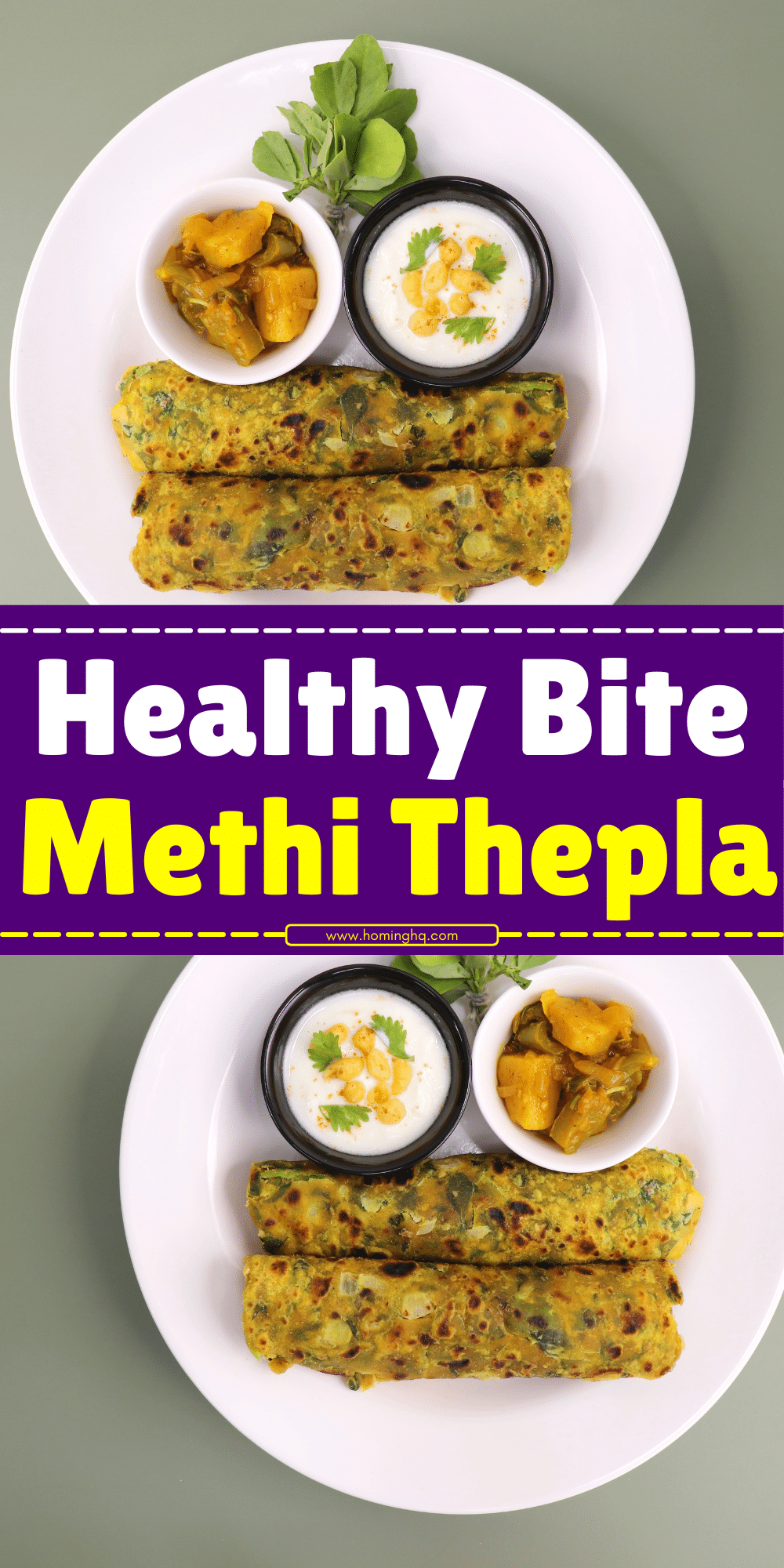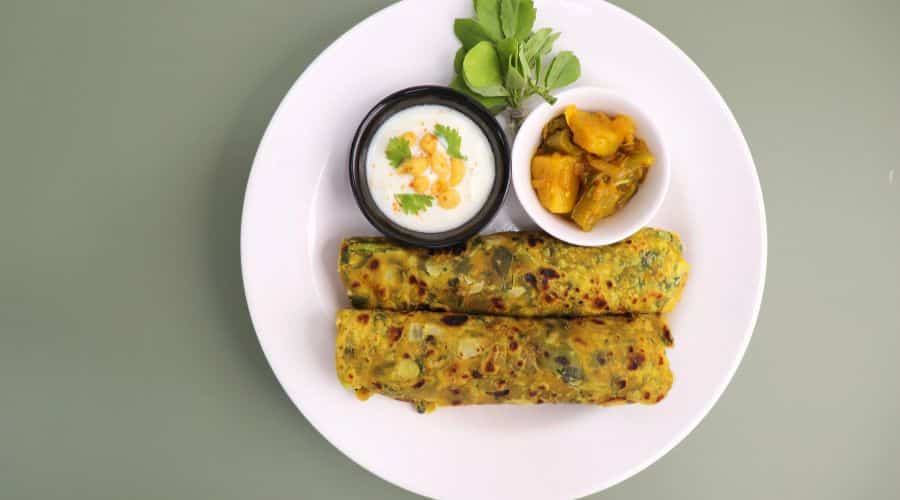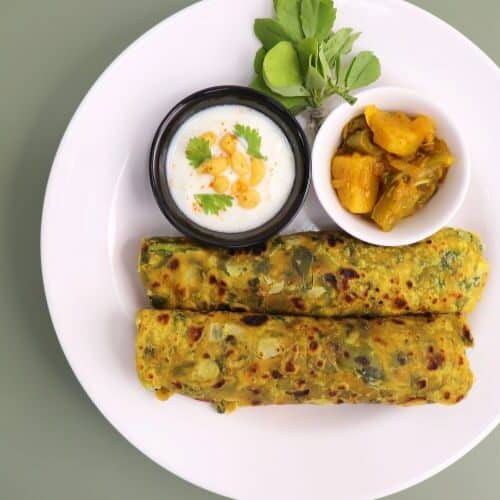Methi Thepla is a delicious and nutritious flatbread from Gujarat, India.
It combines the earthy flavor of fenugreek leaves (methi) with the richness of wheat flour, making it a perfect snack or meal option.
Methi Thepla is known for its soft texture, and it can be enjoyed with yogurt, pickle, or any chutney of your choice.
Whether for breakfast, lunch, or dinner, it’s a versatile and flavorful dish that is beloved across India.

Ingredients Needed for Methi Thepla
To make this delicious thepla, you will need the following ingredients:
- Fresh Fenugreek Leaves (Methi) – 1 cup, finely chopped
- Whole Wheat Flour – 1 cup
- Rice Flour – 2 tablespoons (for crispiness)
- Ginger – 1-inch piece, grated
- Green Chilies – 1 or 2, finely chopped (optional, based on spice preference)
- Turmeric Powder – ½ teaspoon
- Cumin Seeds – 1 teaspoon
- Caraway Seeds (Ajwain) – ½ teaspoon
- Red Chili Powder – ½ teaspoon
- Salt – to taste
- Oil – 1 tablespoon (for kneading and cooking)
- Water – as needed for dough consistency
How to Make Methi Thepla: Step-by-Step Instructions

Step 1: Prepare the Dough
- In a large mixing bowl, combine the whole wheat flour, rice flour, turmeric powder, cumin seeds, caraway seeds, red chili powder, and salt.
- Add the finely chopped methi leaves (fenugreek) and grated ginger. Mix them well into the flour mixture.
- Gradually add water, a little at a time, and knead into a smooth, soft dough. Add oil to the dough for softness and smoothness.
- Once the dough is ready, cover it with a damp cloth and let it rest for 10-15 minutes.
Step 2: Roll the Theplas
- After the dough has rested, divide it into small equal portions (about the size of a golf ball).
- Roll each portion into a smooth ball and flatten it lightly using your palms.
- On a rolling surface, dust each dough ball with some dry flour and roll it out into a thin circle, about 6-7 inches in diameter. Make sure the thepla is not too thick or too thin.
Step 3: Cook the Theplas
- Heat a tawa or non-stick pan on medium heat. Once hot, place the rolled-out thepla on the tawa.
- Cook for 30-45 seconds or until bubbles start to appear on the surface. Flip it over and cook the other side.
- Apply a small amount of oil or ghee on both sides and cook, pressing gently with a spatula until both sides turn golden brown and crispy.
- Remove from the pan and set aside. Repeat the process with the remaining dough balls.
Variations of Methi Thepla
1. Methi Thepla with Garlic
Adding garlic to the dough can elevate the flavor profile of the thepla. Simply add 1-2 cloves of finely minced garlic while mixing the ingredients for the dough.
2. Spicy Methi Thepla
If you enjoy spicy food, you can enhance the heat by adding finely chopped green chilies or red chili flakes to the dough. You can also add some crushed black pepper for an extra kick.
3. Methi Thepla with Yogurt
For a softer texture, you can substitute some of the water with yogurt while kneading the dough. This gives the thepla a rich and slightly tangy flavor.
4. Methi Thepla with Besan (Gram Flour)
To make the thepla more protein-rich, you can add some besan (gram flour) to the dough mixture. It imparts a nice earthy flavor and makes the thepla more filling.
5. Methi Thepla with Sesame Seeds
For a nutty crunch, add a tablespoon of roasted sesame seeds to the dough. It enhances both the texture and flavor of the thepla.
Tips for the Perfect Methi Thepla
1. Use Fresh Methi Leaves
For the best flavor, use fresh fenugreek leaves. Avoid using wilted or old leaves, as they can make the thepla bitter. Fresh methi gives a nice, balanced taste.
2. Knead the Dough Well
Kneading the dough thoroughly is crucial for achieving soft and smooth theplas. Ensure the dough is soft and pliable, but not sticky. Resting the dough for about 15 minutes will help it become easier to roll out.
3. Roll Out Evenly
When rolling the dough, try to maintain an even thickness. If the thepla is too thick, it will be chewy; if it’s too thin, it may become crispy and break. Aim for a uniform 6-7 inch circle.
4. Don’t Overcook
Avoid overcooking the thepla, as it can become hard. Cook each side until golden brown, with small crispy spots, but don’t allow it to burn. The perfect thepla should be soft and slightly crisp on the edges.
5. Use Ghee or Oil for Extra Flavor
For added richness and flavor, brush the thepla with ghee while cooking. Ghee adds a wonderful aroma and enhances the taste.
6. Experiment with Spices
While traditional methi thepla uses basic spices like cumin, ajwain, and chili powder, don’t hesitate to experiment. Add a pinch of garam masala, fennel seeds, or even a little hing (asafoetida) for different variations in flavor.
Health Benefits of Methi Thepla
1. Rich in Iron
Methi leaves are an excellent source of iron, which is essential for the production of red blood cells and for preventing anemia. This makes methi thepla a good choice for people suffering from iron deficiency.
2. Improves Digestion
The fenugreek leaves and spices like cumin and ajwain aid in digestion. Methi is known for its ability to promote a healthy digestive system by reducing bloating, gas, and indigestion.
3. Regulates Blood Sugar
Methi is also beneficial for managing blood sugar levels. The presence of soluble fiber in fenugreek helps in controlling blood sugar spikes and may assist in managing diabetes.
4. Boosts Heart Health
Fenugreek contains fiber, potassium, and antioxidants that are known to support heart health. These components help in reducing cholesterol and lowering the risk of heart disease.
5. Aids in Weight Loss
Methi seeds are known to suppress appetite and enhance metabolism, making them a popular ingredient for those looking to manage or lose weight. The fiber in methi also helps in maintaining satiety for longer periods.
6. Good for Skin Health
The vitamins and minerals present in fenugreek, including Vitamin C and iron, can help in improving skin health. Regular consumption of methi thepla may contribute to a clear complexion and healthy skin.
Serving Suggestions for Methi Thepla
Methi Thepla is a versatile dish that can be paired with a variety of accompaniments to enhance its flavor. Here are some great serving suggestions:
1. With Yogurt (Dahi)
A classic pairing with methi thepla is a bowl of plain yogurt. The creamy and cool texture of yogurt complements the spicy and savory thepla beautifully. You can also add a pinch of salt or cumin powder to the yogurt for extra flavor.
2. With Pickles (Achar)
Indian pickles, especially mango or lime pickles, add a tangy and spicy kick to the thepla. This combination is a popular choice, offering a balance of flavors.
3. With Chutney
Methi thepla pairs wonderfully with chutneys like mint chutney, coriander chutney, or tamarind chutney. The fresh, tangy chutneys enhance the overall taste and make it more refreshing.
4. As a Snack or Breakfast
Serve methi thepla as a wholesome breakfast or a healthy snack. You can enjoy it with a side of tea or coffee for a satisfying meal.
5. Stuffed with Paneer
For a more indulgent option, you can stuff methi thepla with crumbled paneer (cottage cheese) and a few spices. This creates a protein-rich and filling dish, perfect for lunch or dinner.
Conclusion
Methi Thepla is a simple yet flavorful dish that offers a unique combination of spices and the nutritional benefits of fenugreek leaves. Whether enjoyed as a light snack, a hearty breakfast, or a satisfying meal, it is a versatile option that can be customized to suit different tastes. With its easy-to-follow preparation and various serving ideas, methi thepla is sure to become a favorite in your recipe repertoire.
Frequently Asked Questions (FAQs)
1. Can I make Methi Thepla without rice flour?
Yes, you can make methi thepla without rice flour. Rice flour is typically added to provide a crispier texture, but you can substitute it with more whole wheat flour if desired.
2. Can I freeze Methi Thepla?
Yes, you can freeze methi thepla. Once cooked and cooled, stack the theplas with parchment paper in between, and store them in an airtight container or zip-lock bag. They can be frozen for up to a month. Reheat them on a tawa before serving.
3. Can I make Methi Thepla without fenugreek leaves?
While fenugreek leaves are the main ingredient in traditional methi thepla, you can substitute them with spinach or other greens for a variation. The flavor will change, but it will still be delicious.
4. How can I make the dough for Methi Thepla softer?
To make the dough softer, you can add a tablespoon of yogurt or a little more oil while kneading. Resting the dough for 15 minutes also helps in making it more pliable and easy to roll.
5. Can I prepare Methi Thepla with gluten-free flour?
Yes, you can prepare methi thepla using gluten-free flour, such as chickpea flour (besan) or a gluten-free all-purpose flour blend. The texture may vary slightly, but the taste will still be delicious.

Methi Thepla
Equipment
- Rolling Pin – 1 (for rolling out dough)
- Tawa (Griddle) – 1 (for cooking the theplas)
- Mixing Bowl – 1 (for preparing the dough)
- Spatula – 1 (for flipping and pressing the theplas)
- Measuring Cups & Spoons – 1 set (for accurate ingredient measurements)
Ingredients
- Fresh Fenugreek Leaves Methi – 1 cup, finely chopped
- Whole Wheat Flour – 1 cup
- Rice Flour – 2 tablespoons
- Ginger – 1-inch piece grated
- Green Chilies – 1 or 2 finely chopped (optional)
- Turmeric Powder – ½ teaspoon
- Cumin Seeds – 1 teaspoon
- Caraway Seeds Ajwain – ½ teaspoon
- Red Chili Powder – ½ teaspoon
- Salt – to taste
- Oil – 1 tablespoon for kneading and cooking
- Water – as needed to form the dough
Instructions
Prepare the Dough:
- In a large mixing bowl, combine whole wheat flour, rice flour, cumin seeds, caraway seeds, turmeric powder, red chili powder, and salt.
- Add the chopped fenugreek leaves and grated ginger, mixing everything together well.
- Gradually add water, a little at a time, and knead until a soft dough forms. Add oil for softness. Let the dough rest for 10-15 minutes under a damp cloth.
Roll the Theplas:
- Divide the dough into small balls, about the size of a golf ball.
- Roll each dough ball between your palms into a smooth ball, then flatten lightly with your hands.
- Using a rolling pin, roll out each ball into a thin circle, about 6-7 inches in diameter. Dust lightly with flour to prevent sticking.
Cook the Theplas:
- Heat a tawa (griddle) over medium heat.
- Place the rolled-out thepla onto the tawa and cook for 30-45 seconds until small bubbles form on the surface. Flip the thepla and cook the other side for 30-45 seconds.
- Brush with oil or ghee on both sides and cook until golden brown and crispy, pressing gently with a spatula.
- Remove from the tawa and set aside. Repeat the process with the remaining dough balls.
Serve:
- Serve hot with yogurt, pickles, or chutney.
Notes
- Resting the dough is essential to achieve a smooth and soft consistency.
- Adjust spices as per your preference—add more chili powder for extra heat or mix in more spices like garam masala for a richer flavor.
- Storing leftovers: You can store cooked theplas in an airtight container for up to 2 days at room temperature. To reheat, place them on a tawa for a minute or two.
- Vegan Option: You can omit yogurt and ghee and use oil for cooking, making it fully plant-based.

